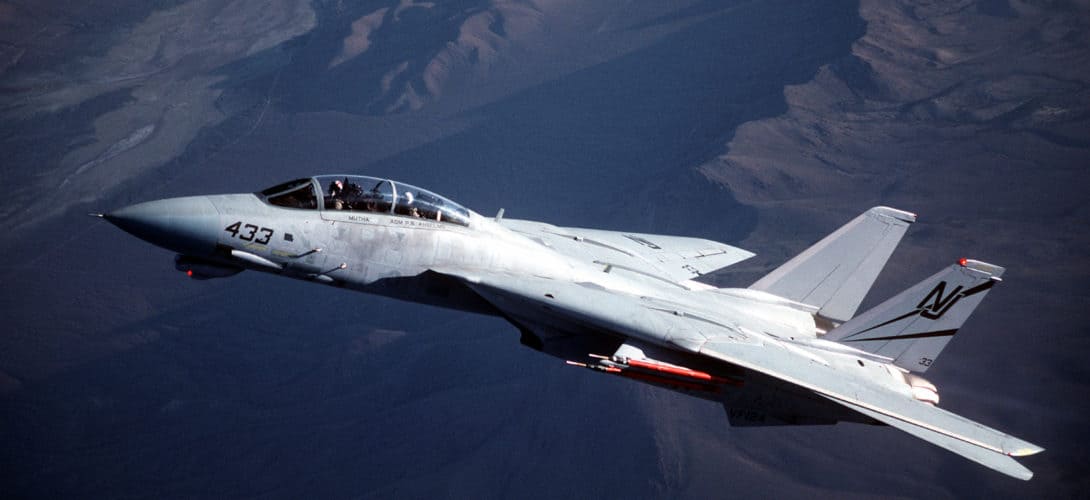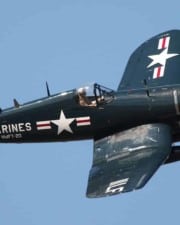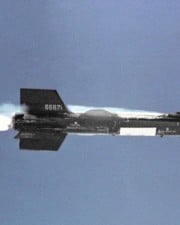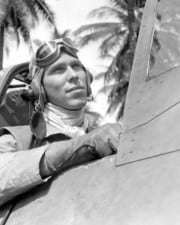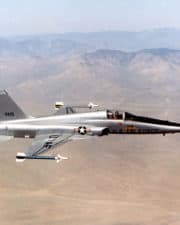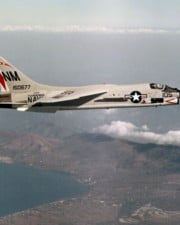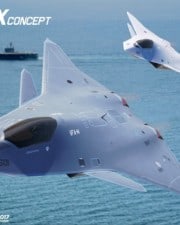On which criteria should we rank the best fighter jet in the world? Well for some people size is all that matters. Bigger must be better, right? So, if that’s you, here are the 11 biggest fighter jets in the world, ranked by length, wingspan and max take off weight.
Roaring through the sky with powerful engines and unparalleled maneuverability, the fighter jet has revolutionized warfare. The technology and speed required of these aircraft are truly remarkable. Anyone who has had the opportunity to see a fighter jet in person can attest that they are one of the most magnificent sights of the modern age.
The first fighter jet was manufactured in 1916. It was the Aeromarine 39 used during World War I. Constructed of wood, it was only considered a fighter jet after the pilots were given bombs to physically throw out of the window onto their targets.
We’ve come a long way from the Aeromarine 39. Today, we have incredibly powerful, huge fighter jets outfitted with guns and bombs that pilots can launch with their aircraft’s controls.
Fighter jets remain the most interesting and intriguing types of aircraft for most people. Many people measure a countries military strength by the type of fighter jets they operate.
The more superior fighter jet will likely end up winning the dog fight. But how is superiority measured when it comes to fighter jets?
Is it in speed? If so, one would choose the fastest fighter jet in the world. Or is the most expensive fighter jet the winner? Or perhaps we need to keep our sights on sixth-generation fighters.
Whatever the right answer is, some people are convinced that bigger is better (Looking at you, America). And they will naturally wonder which country has the biggest fighter jets. Well, we got you covered.
Continue reading to learn about the biggest fighter jets by ordered by exterior length.
11. Mikoyan Mig-35 “Fulcrum-F”
- Wingspan: 39.4 ft
- Length: 56.9 ft
- MTOW: 54,013 lb
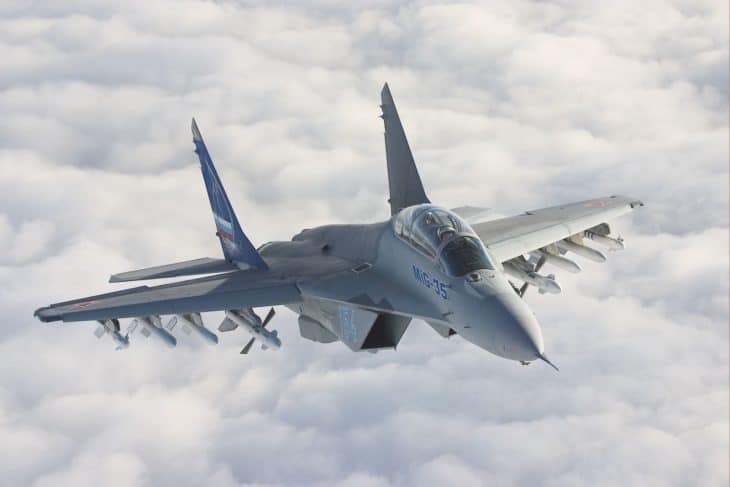
The Russian Mig, Fulcrum-F is a twin-engine aircraft that can seat one or two crew members. It has a wingspan of 39.4 ft, a length of 56,9 ft, a maximum takeoff weight of 54,013 lbs. The Fulcrum-F can reach speeds of up to 1,300 miles per hour.
The Fulcrum-F is armed with an auto cannon and 100 rounds of ammunition, laser-guided rockets, air-to-air missiles, air-to-surface missiles, anti-radiation missiles, anti-ship missiles, and bombs that can be guided by a variety of methods. The Fulcrum-F also contains radar technology and several targeting systems.
The Fulcrum-F was first flown in 1997 and remains in service with the Russian Aerospace Forces. It is believed that there have only been 8 of these jets built to date.
10. Boeing F/A-18E/F Super Hornet
- Wingspan: 44.8 ft
- Length: 60.1 ft
- MTOW: 66,000 lb

The Super Hornet is a twin-engine aircraft seating one crew member in the 18E and two crew members in the 18F. It has a wingspan of 44.8 ft, a length of 60.1 ft, a maximum takeoff weight of 66,000 lbs. It can reach speeds of nearly 1,200 miles per hour.
The Super Hornet is armed with a gun that houses 412 rounds along with short and medium range air-to-air and air-to-ground missiles. It also carries anti-radiation missiles, glide bombs, guided and unguided bombs. The Super Hornet also employs a targeting system, decoys and a variety of radar technology.
First flown in 1995, the Super Hornet is still in service today with the United States Navy as well as the Royal Australian Air Force and the Kuwait Air Force. There have been over 600 of these aircraft built since they were introduced.
9. Lockheed Martin F-22 Raptor
- Wingspan: 44.6 ft
- Length: 62 ft
- MTOW: 83,500 lb
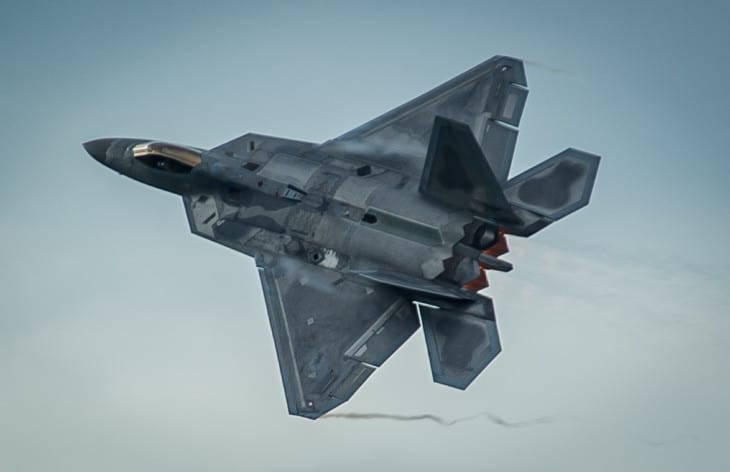
The American-made F-22 Raptor is a twin-engine aircraft seating one crew member. It has a wingspan of 44.6 ft, a length 62 ft, a maximum takeoff weight of 83,500 lbs and a fuel capacity of 26,000 lbs. It can fly at speeds up to 1,726 miles per hour. The Raptor was built to be difficult to track and detect with radar.
The Raptor is armed with a 20 mm rotary cannon holding 480 rounds as well as air-to-air missiles and air-to-ground missiles and small diameter bombs. The Raptor is also equipped with advanced radar technology, including a missile launch detector and a radar-warning receiver that can detect radar detection for a range of 250 nautical miles.
The Raptor was first flown in the late 1990’s and remains in service to this day. It is primarily used by the United States Air Force and there have been a total of 195 of these aircraft built. The Raptor is capable of ground and electronic warfare and also has intelligence capabilities.
8. Grumman F-14 Tomcat
- Wingspan: 64.1 ft
- Length: 62.9 ft
- MTOW: 74,350 lb

The Tomcat is a twin-engine aircraft seating two crew members manufactured by the United States of America. It has a wingspan of 64.1 ft, a length of 62.9 ft, a maximum takeoff weight of 74,350 lbs and a fuel capacity of 16,200 lbs. The Tomcat can reach speeds in excess of 1,500 miles per hour.
The Tomcat is armed with a Gatling cannon which carries 675 rounds as well as 28 rockets, air-to-air missiles, laser-guided bombs, unguided bombs and a targeting system. The Tomcat also has radar and heat-seeking search and tracking technologies onboard.
The Tomcat’s first flight was in the early 1970’s and was first deployed by the U.S. Navy in 1974 aboard the U.S.S. Enterprise. Although the United States no longer uses the Tomcat, it is still in service in Iran.
7. McDonnell Douglas F-15E Strike Eagle
- Wingspan: 42.9 ft
- Length: 63.9 ft
- MTOW: 81,000 lb

The American Strike Eagle is a twin-engine aircraft seating two crew members. It has a wingspan of 42.9 ft, a length of 63.9 ft, a maximum takeoff weight of 81,000 lbs. The Strike Eagle can reach speeds of over 1,600 miles per hour.
The Strike Eagle is outfitted with a Gatling Cannon and up to 500 rounds of ammunition. It also carries a variety of air-to-air missiles, air-to-surface missiles, bombs and countermeasures. The Strike Eagle has been used to provide air support and patrol and to strike against valuable targets.
The Strike Eagle’s first flight was in 1986 and since then it has remained in service. It is used by several countries besides the United States, including Saudi Arabia, Israel and Korea. The United States has deployed the Strike Eagle for operations in Iraq, Afghanistan, Syria and Libya.
6. Sukhoi Su-57 “Felon”
- Wingspan: 46.3 ft
- Length: 65.11 ft
- MTOW: 77,162 lb

The Russian fighter Felon is a twin engine aircraft seating one crew member. It has a wingspan of 46.3 ft, a length of 65.11 ft, a maximum takeoff weight of 77,162 lbs and a fuel capacity of 22,700 lbs. It can reach maximum speeds of 1,320 miles per hour.
The Felon is armed with a gun autocannon, several air-to-air missiles, air-to-surface missiles, anti-ship missiles and anti-radiation missiles. It is also outfitted with targeting systems, countermeasures and a range of different radar technologies.
The Felon is supermaneuverable and has stealth properties. It’s first flight took place in 2010 and it is currently still in service. These jets have an expected service life of up to 35 years. Like many of its Sukhoi counterparts, it has been used during the ongoing Syrian civil war.
5. Chengdu J-20 “Mighty Dragon”
- Wingspan: 42.3 ft
- Length: 66.7 ft
- MTOW: 81,571 lb

The Mighty Dragon is a Chinese twin-engine aircraft seating one crew member. It has a wingspan of 42.3 ft, a length of 66.7 ft, a maximum takeoff weight of 81,571 lbs and a fuel capacity of 26,000 lbs. It can fly at speeds exceeding 1,300 miles per hour.
The Mighty Dragon is armed with short and long range air-to-air missiles, anti-radiation missiles and precision-guided bombs. It is also outfitted with an array of targeting systems and radar.
The Mighty Dragon is a fairly new fighter jet, having made its first flight in 2011. There are currently at least six Mighty Dragons in active service and they are exclusively used by the Chinese People’s Liberation Army Air force.
4. Sukhoi Su-35 “Flanker-E”
- Wingspan: 50.2 ft
- Length: 71.10 ft
- MTOW: 76.509 lb

The Russian Flanker-E is a twin-engine aircraft seating one crew member. It has a wingspan of 50.2 ft, a length of 71.10 ft, a height of 19.4 ft, a maximum takeoff weight of 76,509 lb and an impressive fuel capacity of 25,400 lb. It can fly at speeds of up to 1,500 miles per hour using its Saturn 117S engines.
The Flanker-E is armed with an internal cannon that houses 150 rounds, as well as air-to-air missiles, air-to-surface missiles, and a variety of rockets and bombs.
The Flanker-E is the second largest fighter jet in the world as well as one of the most maneuverable. Its closest rival in maneuverability is the F-22 Raptor (number 8 on our list).
3. Sukhoi Su-30 “Flanker-C”
- Wingspan: 48.2 ft
- Length: 71.9 ft
- MTOW: 76,059 lb
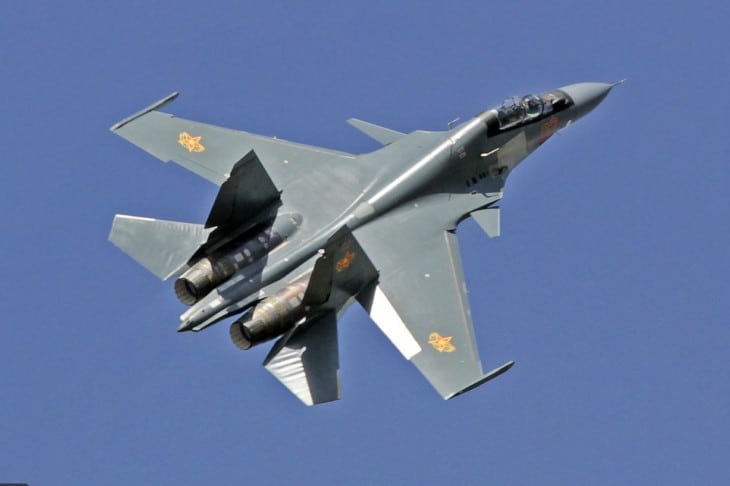
The Flanker-C is a Russian-built twin-engine aircraft seating two crew members. It has a wingspan of 48.2 ft, a length of 71.9 ft, a maximum takeoff weight of 76,059 lbs and a fuel capacity of 20,723 lbs. It can fly at speeds of up to 1,317 miles per hour.
It has an internal auto-cannon capable of firing 150 rounds as well as rockets, air-to-air missiles, air-to-surface missiles, anti-ship missiles and anti-radiation missiles. The Flanker-C also employs the potential use of a variety of bombs, including general purpose and cluster bombs as well as laser-guided bombs.
Introduced in 1996, the Flanker-C is used by a number of countries, including Algeria, Angola, Belarus, China, India, Kazakhstan, Malaysia, Myanmar, Russia, Uganda, Venezuela and Vietnam. It has been used in Syria during the ongoing Civil War there.
2. General Dynamics F-111 Aardvark
- Wingspan: 63 ft
- Length: 73 ft
- MTOW: 100,000 lb
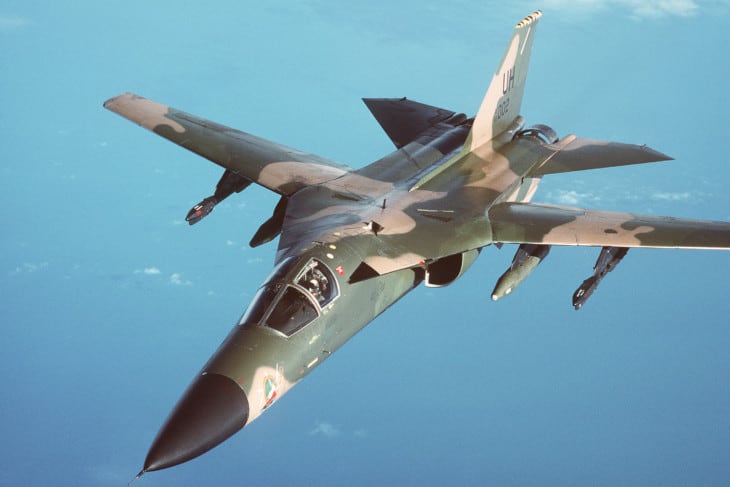
The General Dynamics F-111 Aardvark is a medium-range supersonic interdictor and tactical attack aircraft that also fills the roles of strategic nuclear bomber, aerial reconnaissance , and electronic-warfare. Developed in the 1960s by General Dynamics, it first entered service in 1967 with the United States Air Force.
The F-111 Aardvark is one of the largest and most expensive strike aircraft in history, and was the first swing-wing fighter capable of supersonic speeds in level flight. It has a wingspan of 63 ft, a length of 73 ft 6 in, and a max take off weight of 100,000 lb.
The F-111 pioneered several technologies for production aircraft, including variable-sweep wings, after burning turbofan engines , and automated terrain-following radar for low-level, high-speed flight. Its design influenced later variable-sweep wing aircraft, and some of its advanced features have since become commonplace.
The strength of the F-111 Aardvark was proven in combat during Operation Desert Storm, when 22 F-111 Aardvarks managed to destroy 49 of the 79 Iraqi tanks and armored vehicles that were destroyed by coalition air power. The U.S. Air Force retired its last F-111s in 1998.
1. Tupolev Tu-128 “Fiddler”
- Wingspan: 57.6 ft
- Length: 98.7 ft
- MTOW: 96,342 lb
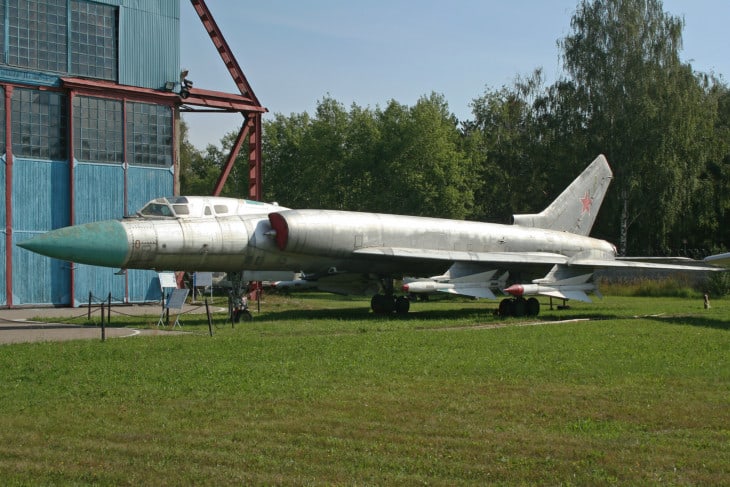

The Fiddler is a twin-engine aircraft seating two crew members. It has a wingspan of 57.6 ft, a length of 98.7 ft, a maximum takeoff weight of up to 96,342 lbs and an impressive fuel capacity of 29,983 lbs. Its turbojet engines thrust it up to speeds of over 1,035 miles per hour when the jet is armed and nearly 1,200 miles per hour when it is unarmed. It is armed with air-to-air missiles that use radar and heat-seeking technologies.
The Fiddler is a Russian product that was mainly built to patrol the air in Siberia where other methods of surveillance were impossible or difficult. There were only about 200 of these fighters ever built and it has only one reported combat operation. During that operation, it reportedly destroyed NATO surveillance balloons.
The Fiddler is the biggest, as well as the oldest fighter plane on this list. It was first introduced and flown in the 1960’s and it was retired for good in 1990.
Related Posts
